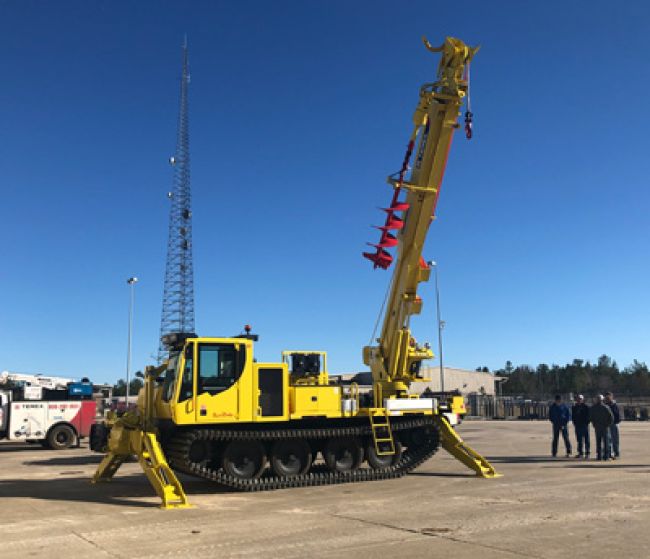
Spec’ing ATUVs for Optimal Performance and Safety
Cooperative Energy, which generates and transmits energy to 11 member systems in Mississippi, recently doubled its line crews to four. It’s no surprise, then, that they’ve “had to have more equipment,” according to Wayne Owens, the company’s fleet maintenance supervisor.
Serving 55 of Mississippi’s 82 counties, Cooperative Energy crews must deal with hills, hollows and swampland, which means that it’s crucial to have an all-terrain utility vehicle (ATUV) that’s right for the diverse terrain.
“You’ve got to have a machine that will be adequate to get where you need to get,” Owens said. “The specs have to start with the terrain.”
Scott Merrill, vice president at tracked vehicle manufacturer PowerBully (www.powerbully.com), agreed that the application drives a lot of spec decisions for ATUVs, which can include wheeled, tracked and amphibious vehicles. “Fording depth is important, too,” he said. “If [the user has] to go through 3- or 4-foot streams and rivers, we make sure that the machine is set up for the ground clearance and the fording depth to get in and out of those situations.”
It’s the planned attachment, however, that plays the most important role, according to Merrill. “The biggest question is, what is the job they need to accomplish and what is the attachment they need for that job?”
Purchasing an ATUV is a collaboration of sorts between users and manufacturers, and that can influence overall vehicle design, said Alain Chabot, product manager for PRINOTH (www.prinoth.com), which manufactures snow groomers and tracked vehicles for the utility and other markets.
With those starting points in mind, decisions can then be made about whether there is a front or rear extension, track options and winches.
Other Factors to Consider
Given the long life of most ATUVs, if you haven’t purchased one in a few years, you’ll notice some changes. Merrill pointed to U.S. EPA Tier 4 standards for engines as well as Stage V standards, which are being adopted in Europe. Then there are the improvements in telematics. “We have a very large amount of data points that we can capture and provide back to the fleet department, as well as the upfitter,” he said. “We provide this in our standard package, and what we would ask from either of them is to tell us the information that they want, and we can provide it.”
Of course, payload and the gross vehicle weight rating must be factored in to ensure that the planned attachment and payload work together. “You don’t want to end up overselling the customer, where he ends up with a bigger machine than he needs,” Merrill said.
At PRINOTH, options include the type of tracks available on the Panther T16 tracked carrier vehicle; customers can choose between metal embedded solid rubber tracks or the more traditional D-dent system. “We listened to the end users, who requested an alternative to allow more versatility when crossing or traveling on roads, as well as being gentler on shop floors when upfitting or maintaining the vehicles,” said Marie-Élaine Dion, PRINOTH’s marketing manager. “We came up with a rugged and proven solution for durability and performance in the construction business on our crawler dumpers.”
Don’t forget service either, which Owens said is extremely important to factor in when making a final ATUV selection. “You have to take into consideration whether there will be someone to work on the machine if you have an issue.”
Given the complexities of the equipment, engineers and technicians from the product manufacturer may need to be brought in to reduce downtime. “When some specific needs are required by customers, our application engineering team is there to propose solutions to overcome the challenge faced by them,” Chabot said.
Clearly, there is no one-size-fits-all solution when it comes to ATUVs. Rather, conversations must take place between the manufacturer, upfitter and fleet to arrive at the best machine for the job.
About the Author: Sandy Smith is a freelance writer and editor based in Nashville, Tennessee.
*****
Don’t Forget These Specs
It’s important to strike the right balance between an all-terrain utility vehicle’s safety and performance options. Working with an ATUV manufacturer can help ensure something doesn’t get overlooked – like the following three items, which should be considered even if they don’t end up as part of the fleet’s spec.
Creature comforts. “The folks in the South would like a pretty robust air-conditioning,” said Scott Merrill, vice president at PowerBully. The cabin should minimize dust and perhaps include a radio or Bluetooth option for traveling long distances to a job site. A comfortable seat with suspension and an overall ergonomic design also is important, he said.
Engine horsepower and an open pad on the pump drive. This enables upfitters to utilize the carrier’s engine for hydraulic power to the attachment, according to Merrill. It might take a conversation between the engineers for the OEM and upfitter, as well as the fleet. “They can really start getting into all the nuances that go into the spec,” he said.
Stabilizers and structure. Rollover protection in an ATUV is paramount. Falling-object protection typically is available as an option. It’s important to ensure that implements installed on the machine do not alter the ROPS certification, said Alain Chabot, product manager for PRINOTH.

